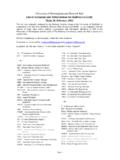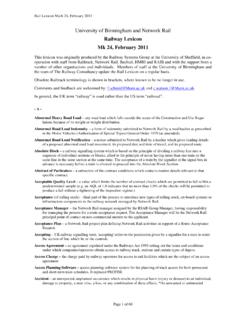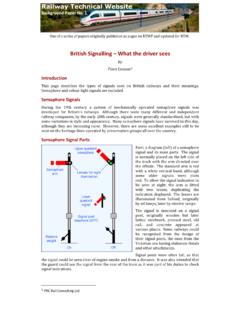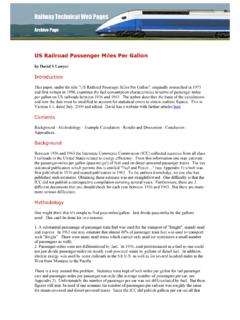Transcription of Railway Technical Website
1 Railway Technical Website Background Paper No. 2 Track Basics by Piers Connor1 Introduction Track is the base upon which the Railway runs. To give a train a good ride, the track alignment must be set to within a millimeter of the design. Track design and construction is part of a complex and multi-disciplinary engineering science involving earthworks, steelwork, timber and suspension systems - the infrastructure of the Railway . Many different systems exist throughout the world and there are many variations in their performance and maintenance. This page looks at the basics of infrastructure and track design and construction with drawings, photos and examples from around the world. Some information was contributed by Dan McNaughton, Simon Lowe and Mike Brotzman. Background The track is a fundamental part of the Railway infrastructure and represents the primary distinction between this form of land transportation and all others in that it provides a fixed guidance system.
2 The track is the steering base for the train and has evolved from an ancient design of vehicle guidance with origins dating, some historians have suggested, from the Sumerian culture of 2000 BC. The modern Railway version is based on the steel wheel running on a steel rail. Other forms of guided vehicle technology exist; rubber-tyred trains, magnetic levitation and guided busways, for example, but these are not dealt with here. There is a good description of the French-based rubber tyred train technology available at The Rubber Tyred Metro Website . Basic Construction Track is the most obvious part of a Railway route but there is a sub-structure supporting the track which is equally as important in ensuring a safe and comfortable ride for the train and its passengers or freight. The infrastructure diagram here shows the principal parts of an electrified, double-track line.
3 The total width across the two-track alignment will be about 15 m (50 ft) for a modern formation. The "cess" shown each side of the alignment is the area available for a walkway or refuge for staff working on the track. The Sub-Structure This part of the road consists of three main elements; the formation, the sub-ballast and the ballast. The formation is the ground upon which the track will be laid. It can be the natural ground level or "grade" or it can be an embankment or cutting. It is important that the formation is made of the right materials and is properly compacted to carry the loads of passing trains. The formation under the track has a "camber" rather like that seen on a roadway. This is to ensure ease of water run-off to the drains provided on each side of the line. The 1 PRC Rail Consulting Ltd. One of a series of papers on Technical issues published by the RTW from time to time.
4 This paper is based on a page on the original Railway Technical Web Pages site. Background Paper Track Basics Railway Technical Website Page 2 Updated 10th May 2017 track itself is supported on "ballast", made up of stones - usually granite or, in the US, basalt - below which is a layer of sand, which separates it from the formation. For new or renewed formations, the sand is normally laid over some sort of geotechnical screen or mesh to separate it from the foundation material below. In the past, asphalt or plastic sheeting has been used to prevent water seepage. Catenary masts (if the line is electrified on the overhead system) are located outside the drains and, beyond them, there is a walkway area. This may just be a cleared path for staff to walk safely, avoiding passing trains or, on modernised routes, a properly constructed path.
5 Next to this path will be a cable trough. These were originally concrete but are nowadays often made of plastic. Cables crossing the track are protected by a plastic tube, usually bright orange in the UK. Proper cable protection is essential to prevent damage by animals, track maintenance tools, weather and fire. Usually, the edge of the Railway property is outside the pathway or cable runs. If the line is built through an area requiring an embankment or cutting, the slopes will be carefully designed to ensure that the angle of slope will not take an excessive width of land and allow proper drainage but without risking an earth slip. The slope angle depends on the type of soil available, the exposure, the climate and the vegetation in the area. Drainage ditches are often added along the edges of cuttings and embankments. In the UK, fences are always provided along the boundary line of the Railway to protect the public from wandering onto the track.
6 Even so, there are a few accidents every year when trespassers are killed or injured by trains or electric conductor rails. Many countries around the world don't fence their railways , assuming people will treat them like roads and look both ways before crossing. They don't. Ballast Ballast is provided to give support, load transfer and drainage to the track and thereby keep water away from the rails and sleepers. Ballast must support the weight of the track and the considerable cyclic loading of passing trains. Individual loads on rails can be as high as 50 tonnes (55 US or short tons) and around 80 short tons on a heavy haul freight line. Ballast is made up of stones of granite or a similar material and should be rough in shape to improve the locking of stones. In this way they will better resist movement.
7 Ballast stones with smooth edges do not work so well. Ballast will be laid to a depth of 9 to 12 inches (up to 300 mm on a high speed track). Ballast weighs about 1,600 to 1,800 kg/cu/m. See also Ballasted vs Non-Ballasted Track below. Track The usual track form consists of the two steel rails, secured on sleepers (or crossties, shortened to ties, in the US) so as to keep the rails at the correct distance apart (the gauge) and capable of supporting the weight of trains. There are various types of sleepers and methods of securing the rails to them. Sleepers are normally spaced at 650 mm (25 ins) to 760 mm (30 ins) intervals, depending on the particular Railway 's standard requirements. Sleepers (Ties) Traditionally, sleepers (known as ties in the US) are wooden. They can be softwood or hardwood.
8 Most in the UK are softwood, although London Underground uses a hardwood called Jarrah wood. Sleepers are normally impregnated with preservative and, under good conditions, will last up to 25 years. They are easy to cut and drill and used to be cheap and plentiful. Nowadays, they are becoming more expensive and other types of materials have appeared, notably concrete and steel. Background Paper Track Basics Railway Technical Website Page 3 Updated 10th May 2017 Concrete is the most popular of the new types (left). Concrete sleepers are much heavier than wooden ones, so they resist movement better. They work well under most conditions but there are some railways which have found that they do not perform well under the loads of heavy haul freight trains. They offer less flexibility and are alleged to crack more easily under heavy loads with stiff ballast.
9 They also have the disadvantage that they cannot be cut to size for turnouts and special trackwork. A concrete sleeper can weighs up to 320 kg (700 lbs) compared with a wooden sleeper which weighs about 100 kg or 225 lbs. The spacing of concrete sleepers is about 25% greater than wooden sleepers. Another type of concrete sleeper is shown in this drawing (left). This is the twin-block sleeper. The design consists of two concrete blocks joined by a steel bar. It is 30% lighter than a regular concrete sleeper, allowing it to be moved manually. It is popular in France (where it is called Stedef) and for some lighter track forms like those used for tramway systems. Here is an example in Sheffield (below). The photo shows twin block and wooden sleepers in the same track. The sleepers shown in the above photo are supplemented with wooden sleepers at the crossover, because it is easier to cut the timber to the correct size.
10 Sleepers at crossovers and turnouts vary in size according to their position in the layout. Steel sleepers are also now used on more lightly used roads, but they are regarded as suitable only where speeds are 100 mi/h (160 km/h) or less. In the US most ties are made of oak soaked in creosote, cost on average between $22-$29 each. Iit used to be up to $35-$40 per tie in the late 80's. They can last up to 20 years. Most Class 1 RR's will replace them after 5-10 years and then sell them as used. Concrete ties are $42 dollars. They are popular in the western US and on passenger lines in the east. Recently, composite ties have Background Paper Track Basics Railway Technical Website Page 4 Updated 10th May 2017 come on the market. They are made of something like old tires and recycled plastic.






